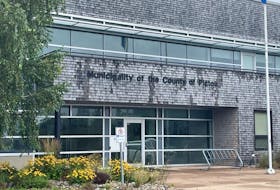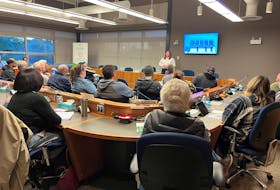BON PORTAGE ISLAND, SHELBURNE COUNTY - Research students on Bon Portage Island found themselves in a winged goldmine recently during a bird fallout.
The term is used by birders and refers to the aftermath of severe weather preventing migratory birds from reaching their destination. The exhausted birds often end up resting in one area.
Bon Portage Island, located just off Shag Harbour Island, is owned by Acadia University.
The Richardson Field Station in Biology operates on the island and is maintained by the Department of Biology. The Natural History Field Course is offered here and the island is an important site for student research. The Atlantic Bird Observatory also operates banding stations at this location.
Evelyn and Morrill Richardson were lighthouse keepers for 35 years here. Evelyn Richardson wrote six books, including We Keep a Light.
David Bell, originally from Sault Ste. Marie, Ont., and Lucas Berrigan from Jeddore Harbour, N.S., spent many weeks on Bon Portage Island this summer banding birds caught in a mist net.
Bell, an avid weather observer, tries to predict what types of birds they should be looking for, given the weather conditions across North America.
He noticed that the setup on Oct. 25/26 was similar to a weather system that brought a large fallout of birds in October 1998, with a front moving offshore quickly from Florida, but stalling and “bombing” out over the Maritimes.
“This kind of setup late in the season can 'suck' birds up from the south, and it just happened that this one was a significant event,” he said.
“When Lucas found some indigo buntings and a gray catbird on the evening of the 26th, I had a suspicion that we were in for some good birding the next day, and put the word out on the Rare Bird Alert for people to be alert.”
Bell says he’s learned over time that Nova Scotia is a great place for finding vagrants.
“The average winds in North America converge here, bringing birds from all over the continent into the province.”
A side project that Bell has been working on is the detectability of vagrants, using radio tags to know which birds are on the island versus which they are actually seeing in a day of birding.
“So far, even on a small island like Bon Portage where we actively look for birds every day, our detection rates are only 10-20 per cent, meaning we are likely missing 80-90 per cent of the vagrants that actually show up on the island.
“Over the rest of the province, effort is more spread out, meaning we are likely missing far more. It's interesting to think about this, given the large number of vagrant birds that are already found in the province in a given year,” he said.
The fallout was an incredible experience, he says.
“Having flocks of indigo buntings hopping at your feet, and every net run yielding some new vagrant that we might only see once or twice a season in a normal year is what we normally can only dream of,” he said.
“To give it a bit of perspective, in a normal year we see one or two white-eyed vireos; we had 13 one day. I've seen two yellow-throated warblers in the past five autumns on the islands; in the fallout we had 11 in a day. I could go on, but I also added two new birds to my Bon Portage list (summer tanager and golden-winged warbler), something that is tough to do these days as I've now seen 269 species of birds on the island. Even better, we managed to capture and band both of them.”
Berrigan says the event was definitely the best experience he’s had since his first time on Bon Portage in 2006.
“But I could even say the best in my days as a birder,” he added.
He even went out to see new arrivals in the rain, at around 4 p.m. on the 26th. It didn’t take long before he found the three indigo buntings and a gray catbird; however, this was only a small taste of what was to come.
“Rare birds really starting pouring in the next morning on the 27th as we started work. At first Dave spotted a yellow-throated vireo, then a white-eyed vireo, then we caught a beautiful adult male hooded warbler, two summer tanagers (one was also an adult male), and a golden-winged warbler,” he said.
When it seemed like things couldn’t get better, they would find another amazing bird. Once they were done their work they birded non-stop until nearly sunset and found a number of others, including six yellow-throated warblers and about a dozen more indigo buntings, a clay-coloured sparrow and a few yellow-billed cuckoos.
On Oct. 28 Berrigan and other students saw 81 species, including 22 species of warblers.
Part of Berrigan’s and Bell’s work on the island included the attachment of a small radio transmitter to vagrants. The device weighs around three per cent or less of the bird’s body weight
The transmitters send a unique ID to receivers that are within range. A large network of receivers has been deployed around Atlantic Canada and the northeastern U.S. that allows researchers to track birds at larger scales than before (see Motus.org)
Bon Portage Island fallout lists
Interested in seeing lists of some of the species recorded during the fallout?
Interested in visiting Bon Portage Island?
Permission must be obtained prior to.
Visit this link: Atlantic Bird Observatory








